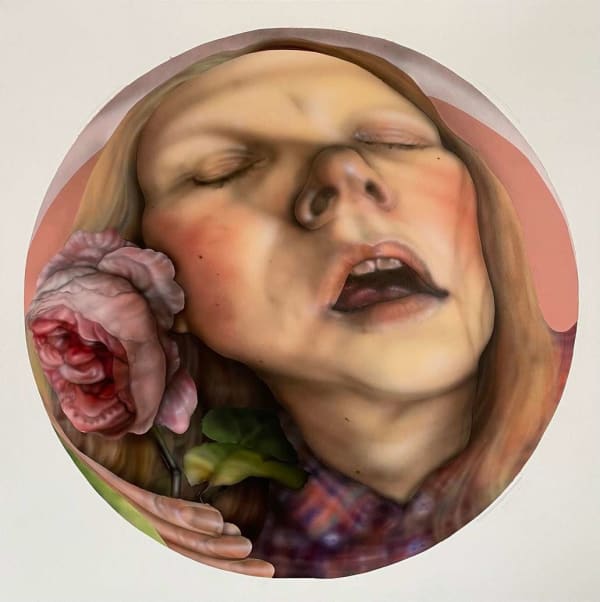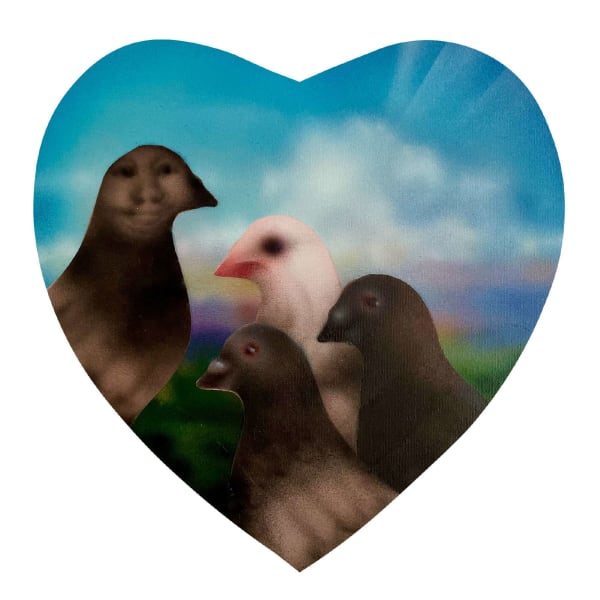HELENA MINGINOWICZ: WOUNDS AND WONDERS
OPENING ON MAY 15, 2025, AT 6:00 PM
Helena Minginowicz's paintings possess a rare quality: language fails to fully capture them. The evocative scenes she depicts feel infinitely unique, yet strangely familiar—as if glimpsed before in dreams, whether lucid or lysergic. Each viewer is thus compelled to search the recesses of their mind, driven by the elusive desire to recapture these whimsical images of muted dreaminess. At the very moment rationality recedes, a hypnagogic vertigo opens beneath our feet.
This first exhibition in France of Helena Minginowicz, born in 1984 in Poznań, introduces us to her distinctive figurative universe and her preferred motifs. To reach this point, the artist—who graduated from the University of the Arts in her hometown in 2011—had first to unlearn the principles of classical painting. She constructed a personal pantheon, blending alchemical spell books, Italian Renaissance masters, and Young British Artists. Later, she rejected modernist expressivity, trading brushes for spray cans. Her distinctive approach, carving space through transparency and overlapping layers, was thus born.
In Minginowicz’s work, interior and exterior spaces blur, occasionally reversing entirely. Skin, membranes, hair, lace—but also worn dishcloths and drifting plastic bags—all these unstable surfaces, alternately pulsating, iridescent, metallic, or moist, become the disembodied subjects of a wordless intrigue. About her artistic quest, Minginowicz explains that she aims to depict the "filters" existing between reality and perception. In her Paris exhibition, for example, a pair of kneecaps display an ominous grin (Off!, 2024), while a sheet swells into a chilling scream (undercover, 2024). No figure fully emerges; each fragment serves as the canvas for another silhouette, created through hybridizations of human, animal, and microplastic forms.
An immediate connection emerges with surrealist imagery, rooted in unexpected encounters. A more contemporary comparison can also be drawn with the "weird," as defined by writer Mark Fisher in the context of horror culture, distinguished from the "eerie." Where the latter applies to threatening external spaces, the "weird" targets deceptively familiar everyday settings. It represents a "particular disturbance," embodied by "an entity or object so strange that it makes us feel it should not exist—or at least not here."[1] Minginowicz's work fully embodies this notion: we willingly remain captive in a paradoxical space-time, entangled by its siren-like allure.
More specifically, Helena Minginowicz refracts our collective unconscious through the lens of internet culture, the ambient iconographic environment we inhabit almost unknowingly. Through her paintings, we recognize that our symbols and imaginative references are neither fixed nor pure but are instead contaminated by cursed imagery, fleeting #corecore micro-trends, and sponsored content. When this Y2K-inflected remixed unconscious resurfaces, it manifests as a subterranean cosmology, what philosopher Federico Campagna terms "magical[2]"—the glittering, inverse mirror of our gray techno-scientific universe.
Ingrid Luquet-Gad
-
 Helena Minginowicz, Beauty Mask, 2024
Helena Minginowicz, Beauty Mask, 2024 -
 Helena Minginowicz, All the white horses, 2024
Helena Minginowicz, All the white horses, 2024 -
 Helena Minginowicz, It's not working anymore, 2024
Helena Minginowicz, It's not working anymore, 2024 -
 Helena Minginowicz, Off!, 2024
Helena Minginowicz, Off!, 2024
-

Chez Prima, le sfumato extatique d'Helena Minginowicz
Chirine Hammouch, The Steidz, June 3, 2025 -

Helena Minginowicz
Renaud Monfourny, Le Photoblog de Renaud Monfourny, May 24, 2025 -

Art Brussels : une jeune création internationale en 10 artistes
Maxime Gasnier, The Steidz, April 29, 2025 -

13 artistes à suivre
Camille Bardin, Projets Media, April 25, 2025 -

Art Brussels : 5 artistes à découvrir sur la foire
Camille Bois-Martin, Numéro Art, April 25, 2025




















